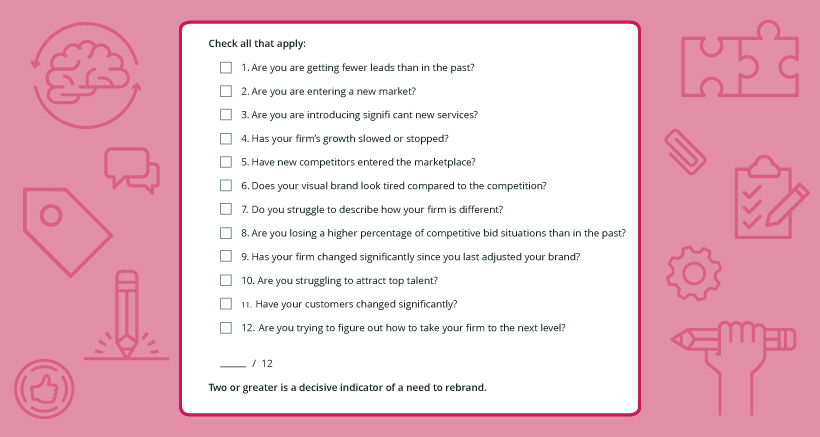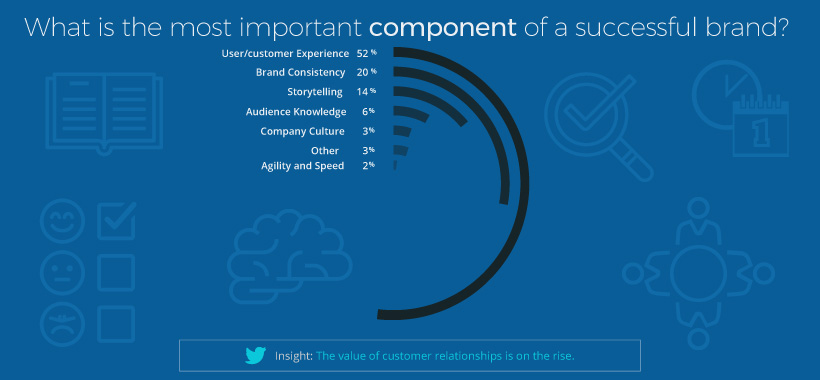Website rebranding takes time, consideration and planning. Before you get started, consider the business reasons and goals for a rebrand. Next, define your rebrand project plan, develop your brand positioning and new site design, then make a plan for measuring post launch activity.
Rebrand. The very moment that word is spoken, the majority of us content marketers begin searching for the nearest exit. Which is exactly why developing a rebranding strategy is imperative for our survival. We’ve all gone through rebranding headaches at some point. Anyone who has survived a rebrand can relate to the pressure and stress that come with the territory. We are haunted by valid fears, such as:
- Is our traffic going to tank?
- Is our SEO positioning going to drop too?
- Do we have to rebuild our entire brand messaging from scratch?
- Is it worth the time and effort right now?
- Or, can we keep using the same tired website we’ve been using since 2005? (Don’t do this.)
A website rebrand is not a one-man show. It requires all-hands on deck and an intentional rebranding strategy to steer the ship. Whether you’re knee-deep in a rebrand, or you can sense one looming, we’re here to make life easier with this rebrand survival guide that is custom-built for content marketers.
Why a rebranding strategy is imperative for survival
A website rebrand is just like any other marketing initiative. Do you dive in with your eyes closed and hope for the best? No. If you want to survive, you mastermind a plan.
For some reason when it’s time for a rebrand, strategy tends to fly right out the window. Being that a website project is already a substantial undertaking, skipping over a rebranding strategy just adds to the chaos. Rebrands are also expensive. So being efficient with resources is yet another reason to develop a strategy.
There are three stages for a rebrand: before, during, and after.
As you develop your rebranding strategy, think about all of the components that need to be considered during each of these stages. Most of the time we are focused on “during” and we don’t plan enough before or analyze enough after.
Without prepping for a website rebrand, you risk running into resource and budget constraints that will make the project drag on forever. Or worse, you’ll have a pricey, unfinished website that never sees the light of day.
And after you go live? A rebrand doesn’t have an ending, because your website is a living, breathing thing. Just like a person, it has interactions and creates experiences with real people: your audience. What you learn after the website rebrand can make a legitimate impact on the ROI all of your marketing efforts.
Is it time for a rebrand?
It’s a justifiable question to ask before spending tons of moola and man hours on a new direction for your website. Remember that your website is your livelihood. In other words, brushing off a website rebrand because of budget and time constraints isn’t the best move either. Your brand’s reputation is in a vulnerable position when your website isn’t up to snuff.
Here are some questions to sift through to help you determine if it’s time for a website overhaul:

For those of you that checked off two or more of the questions above… Congratulations? All jokes aside, it is just cause for a high-five. Your decision to rebrand means you’re open to investing back into your brand to make your company more successful.
Knowing your current website challenges — be they a decrease in conversions or a stale feeling with your brand — will come in handy during the initial stages of your rebranding strategy. Being specific about how you are going to overcome these challenges will determine the type of rebrand you need.
A rebrand has many faces. Not everybody requires the works, with an overhaul of the visual brand and messaging all the way down to a revised keyword strategy for SEO. Maybe your brand is as fresh as a daisy, but your products or services have changed drastically. Maybe the company’s vision shifted since you started the company blog five years ago, and you need a content strategy to support that shift.
The purpose of a website rebrand is essentially the same for every company: to put your best “branding” foot forward in support of reaching your revenue objectives. No matter what kind of scenario merits your decision to rebrand, calculated steps will make life much more bearable throughout the process.
“A brand for a company is like a reputation for a person. You earn reputation by trying to do hard things well.” – Jeff Bezos
7 core mantras for surviving your next rebrand
While there are no shortage of rebranding resources for designers, as a content marketer in the midst of a rebrand, how-to’s are harder to find out there. So here is some moral support to guide you toward the light at the end of the tunnel of a rebrand launch and beyond.
1. Define your goal.
Defining the goal is an old standby with any marketing initiative, for good reason. It grounds us when we’re flying in different directions, which is most often the case with a website rebrand when teams are highly attached and stressed. Establishing the goal is incredibly important for morale throughout the entire the lifecycle of the process.
Before the rebrand, it gives clear direction to make sure everyone is working toward bringing the same vision to life. During the rebrand, the goal is there when things inevitably get tough and your team needs to remember “the why” behind their hard work. After the rebrand wraps up, referencing the initial goal brings everything full circle.
What are you hoping to achieve with your website rebrand? Now is a good time to revisit the reason why you decided to make the investment and how you are going to make that investment worth it.
2. Lay down your strategy.
How will you reach the goal you defined? Spell out the content strategy that will get you there. Depending on the type of rebrand journey you embark upon, the strategy will look different. You might be:
- Company A – You have a new snazzy website that is spot-on visually and content that jives with your updated brand strategy. But nothing is optimized for SEO, and you’re ranking on page two of the search results where nobody can find you.
- Company B – You powered through a full-fledged rebrand last year and now you’re taking your long-term content strategy in a new direction. You need this to work. You need to see ROI. No pressure.
- Company C – You look down in shame, because it’s been five years since your last website rebrand. Thankfully the website still functions, but there’s a big disconnect affecting the current and future success of your entire business.
Company A needs SEO. Their website looks nice, but without an SEO foundation, they are doomed to be a wallflower that goes unnoticed by the majority of people who never make it past page one.

Company B needs retargeting. Adjusting their strategy will involve taking a long look at the people their content needs to speak to, from buying stages to personas. Messaging and SEO must connect the dots.
Company C needs the works. They are at risk of being left behind with an outdated website, and they are likely facing issues with prospects not having a clue how Company C can help them. A deep dive into SEO keyword research and brand foundations will help set the tone for their entire strategy.
No matter your website rebrand situation, your website’s SEO focus should be revisited annually. Industry landscapes change, as do buying behaviors. Staying on top of the latest keyword data will ensure your website is optimized for the people you are aiming to attract.
3. Live your brand foundations.
A strong website captures the essence of your brand. The story of who you are, what you do, and why you exist shines through the content of the most successful brands. They are living their brand foundations.
Brand foundations don’t need to be spelled out on the About page as: here is our mission, this is what we value, we envision a better world without [people saying marketing is sexy]. Your website is your brand and you want the content to convey that message, to sound the way your brand would sound if it could talk.

A rebrand is one of the best times to check yourself. Is there too much mission and not enough vision? Make sure you know the difference between a mission and a vision statement, and that your website is illustrating both.
If you think the brand messaging is clear but you aren’t 100% sure, enlist any willing clients and partners to share their reactions to your existing website. If your brand messaging is working on your website, in an uncanny way, their words and feelings will be completely in sync with your mission, vision and values.
4. Gather your troops.
You’re basically going into battle with a website rebrand, so you need the strongest team imaginable to pull it off. However, that team might not be the one you usually collaborate with.
Obviously a lot of work goes into a website rebrand, and other work doesn’t get put on hold. You might have a superstar marketing team, but they presumably don’t have hundreds of hours to dedicate to a rebrand project. Even if your team does have the bandwidth, they may not have the specific skills to get the job done.
This is where outsourcing is a godsend. We are fortunate to live in a vibrant freelance economy, where we can hire support at will for one-off and ongoing projects.
Freelance copywriters and SEO consultants are ideal resources during a website rebrand, because they can handle the additional responsibilities your team can’t focus on. Many specialize in rebranding, so they understand how they can fill in the gaps while staying true to your brand and vision.
5. Dive into your analytics.
Before finalizing the game plan for a website rebrand, review existing analytics so data drives the decision-process. During a rebrand, anyone — regardless of role — can fall victim to their emotions.
It makes sense, when you realize how close each team member is to the company website. Everyone takes some level of ownership, so yeah… It’s personal. Which is why turning to the data will not only keep the peace, but also inspire smarter choices. By establishing a baseline measurement for traffic and conversions now, you can measure success post-rebrand.

For visual guidance, CrazyEgg is extremely helpful. If you’re wondering whether you should rename features or reposition them on a product page, check out click engagement with heat mapping. Then you can spot which features your audience engages with, and which get left out in the cold.
In Google Analytics, check out the following:
- Which content has performed well? Which content flopped?
- Which pages on your site see the most traffic? Which pages need more love?
- Which pages convert?
- Which pages have the highest bounce rate?
- Are visitors taking the path you want them to?
- Are there any patterns?
If you are tracking keyword ranking performance in a tool like Moz Pro, you can see where your webpages rank for all of your target keywords. If you have pages ranking in the top 20 search results, you may prioritize revamping that content to get to the top 10, or top three — gaining precious traffic and increased click-through along the way.
6. Optimize your content.
Take your fingers off the keyboard — don’t write. Before creating any new content, keyword research is paramount. More and more, SEO is becoming the writer’s responsibility. Free tools like Answer the Public are the perfect weapon when you’re drafting valuable content that focuses on questions people are asking.
Get spreadsheet happy and group your keywords by niche topic. Including several contextually related keywords for any given piece of content signals to the search engine gods that your content has topic authority.
While auditing your existing content, look for easy SEO opportunities along the way. Check out the URL, page title and meta description of each page. Is the target keyword used in all three? Good, you’ve got your SEO bases covered.
Taking a deeper dive into a wonderfully optimized website, make sure to create compelling content with your focus keywords. In other words, don’t keyword stuff and remember the human reading it.
Your meta description is a chance to engage users so they click, which ultimately drives traffic to your website. It should have the focus keyword, of course, but it needs an enticing CTA too. For on-page content, use keywords tastefully. For example, don’t bother front-loading headers with keywords if it produces a lackluster reading experience.
Lastly, a key thing to remember is that every blog post is a web page. So, treat them with the same SEO care. A content audit can help you identify opportunities for SEO optimization on existing pages, including topics that are sterling candidates for evergreen content.
7. Analytics time… AGAIN.
How do you know a website rebrand worked? The answer lies in the data. Just because you launched doesn’t mean your work is done. In many ways, a whole new phase is beginning.
Return to Step 5 and revisit your baseline measurements. Dive back into the analytics tools you worked with (i.e. CrazyEgg, Google Analytics and Moz Pro) to see your performance.
In a perfect post-rebrand world, your heat map tool will show users engaging heavily with revenue generating pages. Your bounce rates will improve, as will user behavior flow patterns and time on page. Your ranking will increase for focus long-tail keywords, as will traffic.
If things aren’t anywhere near perfect, then make the necessary adjustments to influence more positive results. Analyze insights for a period of 1-3 months before updating content. The goal is to give yourself enough time for gathering a healthy data set that you can learn from. Make incremental changes and test them, rather than making constant drastic changes that confuse the search engine robots and negatively impact your ranking.
As content marketers, we are always testing, learning and growing. A website rebrand is no different from any other project. In fact, analyzing the work that we do here is arguably a priority we should spend more time on.

Let’s be real. We all secretly want to push the fast-forward button and have a shiny, user-friendly, SEO-optimized website. The reality is that we have to do the work, and our other work doesn’t stop for a rebrand.
A website rebrand doesn’t have to be a scary experience for you and your team. Take the time to develop a rebranding strategy, so you can combat a topsy-turvy experience with clarity and confidence.



